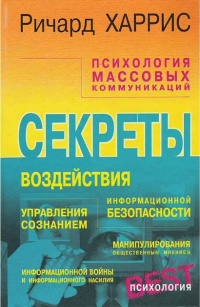Читать книгу - "Психология массовых коммуникаций - Ричард Харрис"
Аннотация к книге "Психология массовых коммуникаций - Ричард Харрис", которую можно читать онлайн бесплатно без регистрации
Taylor, C. R., Lee, J. Y, Stern. В . В . (1995). Portrayals of African, Hispanic, and Asian Americans in magazine advertising. American Behavioral Scientist, 38, 608–621.
Taylor, S. (19S2). The availability bias in social perception and interaction. In: D. Kahneman, P Slovic, A. Tversky (Eds.). Judgment under uncertainly: Heuristics and biases (p. 190–200). Cambridge, England: Cambridge University Press.
Teplin, L. A. (1985). The criminality of the mentally ill: A dangerous misconception. American Journal of Psychiatry, 142, 593-599.
Thaler, R (1994). The watchful eye: American justice in the age of the television trial. New York: Praeger. Thomas, S. (1986). Gender and social-class coding in popular photographic erotica. Communication Quarterly, J4(2), 103–114.
Thompson, T. L., Zerbinos, E. (1995). Gender roles in animated cartoons: Has the picture changed in 20 years? Sex Roles, 32, 651–673.
Thorndyke, P. W. (1984). Applications of schema theory in cognitive research. In: J. R. Anderson S. M. Kosslyn (Eds.). Tutorials in learning and memory (p. 167–192). San Francisco: Freeman.
Thorson, E. (1990). Consumer processing of advertising. Current Issues and Research in Advertising. 12, 197–230.
Thorson. E. (1994). Using eyes on screen as a measure of attention to television. In: A. Lang (Ed.). Measuring psychological responses to media (p. 65–84). Hillsdale NJ: Lawrence Eribaum Associates.
Thorson, E., Christ, W. G., Caywood, C. (1991). Selling candidates like lubes of toothpaste: Is the comparison apt? In F. Biocca (Ed.). Television and political advertising, Vol. I: Psychological processes (p. 145–172). Hillsdale, NJ: Lawrence Eribaum Associates.
Tinic, S. (1997). United Colors and untied meanings: Benetton and the commodification of social issues. Journal of Communication, 47(3), 3–25.
Toney, G. T, Weaver, J. B. (1994) Effects of gender and gender role self-perceptions on affective reactions to rock music videos. Sex Roles, 30, 567–583.
Took, K. J., Weiss, D. S. (1994). The relationship between heavy metal and rap music and adolescent turmoil: Real or artifact? Adolescence, 29. 613–621.
Toplin. R. B. (1995). History by Hollywood: The use and abuse of the American past. Urbana: University of Illinois Press.
Tower. R. В ., Singer. D. G., Singer, J. L. (1979). Differential effects of television programming on preschoolers' cognition, imagination, and social play. American Journal of Orlhopsychiatiy, 49, 265–281.
Trenaman, J., McQuail, D. (1961). Television and the political image: A study of the impact of television on the 1959 general election. London: Methuen.
Trevino, L. K.. Webster, J. (1992). Flow in computer-mediated communication: Electronic mail and voice mail evaluation and impacts. Communication Research, 19, 539–573.
Tuchman, G. (1978). Making news: A study in the construction ofreality. New York: Free Press.
Tuchman, G. (1987). Mass media values. In: A. A. Berger (Ed.). Television in society (p. 195–202). New Brunswick, NJ: Transaction Books.
Tuchman, S., Coffin, Т . Е . (1971). The influence of election nights television broadcasts in a close election. Public Opinion Quarterly, J5, 315–326.
Tulloch, J. (1989). Australian television and the representation of AIDS. Australian Journal of Communication, 16, 101–124.
Tulloch, J., Chapman, S. (1992). Experts in crisis: The framing of radio debate about the risk of AIDS to heterosexuals. Discourse and Society, 3, 437–467.
Tulloch, J., Kippax. S., Crawford. J. (1993). Television, sexuality, and AIDS. Sydney, Australia: Alien Unwin.
Tunstall, J. (1977). The media are American. New York: Columbia University Press.
Tversky, A., Kahneman, D. (1973). Availability: A heuristic for judging frequency and probability. Cognitive Psychology, 5, 207–232.
Tversky, A., Kahneman. D. (1974). Judgment under uncertainty: Heuristics and biases. Science. 185, 1124–1131.
TV vs. reality (1998, June II). Kansas State Collegian. p. 7.
Twenty-first century Singapore. (1992, August). World Press Review, p. 45.
Туе , J. В ., Warner, K. E., Glantz. S. A. (1987, Winter). Tobacco advertising and consumption: Evidence of a causal relationship. Journal of Public Health Policy, p. 492–508.
Ume-Nwagbo, E. N. E. (1986). "Cock Crow at Dawn" A Nigerian experiment with television drama in development communication. Gazette, 37(4 155–167).
U. S. Commission on Obscenity and Pornography. (1970). The report of the Commission on Obscenity and Pornography. New York: Bantam.
Valente, J. (1997, March 2). Do you believe what newspeople tell you? Parade, 4–6.
Valkenburg, P. M., van der Voort, T. H. A. (1994). Influence of TV on daydreaming and creative imagination: A review of research. Psychological Bulletin, 116, 316–339.
van der Voort, T. H. A. (1986). Television violence: A child's eve view. Amsterdam: North-Holland.
van der Voort, T. H. A., Valkenburg, P. M. (1994). Television's impact on fantasy play: A review of research. Developmental review, 14, 27–51.
van Dijk, T. A. (Ed.). (1985 a). Discourse and communication. Berlin, Germany: deGruyter.
van Dijk, T. A. (1985 b). Introduction: Discourse analysis in (mass) communication research. In: T. A. van Dijk (Ed.). Discourse and communication (p. 1–9). Berlin, Germany: deGruyter.
van Dijk, T. A. (1988). News as discourse. Hillsdale, NJ: Lawrence Eribaum Associates.
van Evra, J. P. (1997). Television and child development (2nd ed.). Mahwah, NJ: Lawrence Eribaum Associates.
Vidmar, N., Rokeach, M. (1974). Archie Bunker's bigotry: A study in selective perception and exposure. Journal of Communication, 24(1), 35–47.
Vincent, I. (1996, June II). Rebel dispatches on the Net. World Press Review, 23–24.
Vincent. R. C., Davis, D. K., Boruszkowski, L. A. (1987). Sexism on MTV: The portrayal of women in rock videos. Journalism Quarterly, 64(4), 750–755.
Vokey, J. R., Read, J. D. (1985). Subliminal messages: Between the devil and the media. American Psychologist, 40, 1231–1239.
Volgy, T. J.. Schwarz, J. E. (1980). TV entertainment programming and sociopolitical altitudes. Journalism Quarterly, 57, 150–155.
von Feilitzen, C., Strand, H., Nowak, K., Andren, G. (1989). To be or not to be in the TV world: Ontological and methodological aspects of content analysis. European Journal of Communication, 4, 11–32.
Vorderer, P., Wuiff, H. J., Friedrichsen, M. (Eds.). (1996), Suspense: Conceptualizations, theoretical analyses, and empirical explorations. Mahwah, NJ: Lawrence Eribaum Associates.
Прочитали книгу? Предлагаем вам поделится своим впечатлением! Ваш отзыв будет полезен читателям, которые еще только собираются познакомиться с произведением.
Оставить комментарий
-
 Гость Алла10 август 14:46
Мне очень понравилась эта книга, когда я её читала в первый раз. А во второй понравилась еще больше. Чувствую,что буду читать и перечитывать периодически.Спасибо автору
Выбор без права выбора - Ольга Смирнова
Гость Алла10 август 14:46
Мне очень понравилась эта книга, когда я её читала в первый раз. А во второй понравилась еще больше. Чувствую,что буду читать и перечитывать периодически.Спасибо автору
Выбор без права выбора - Ольга Смирнова
-
 Гость Елена12 июнь 19:12
Потрясающий роман , очень интересно. Обожаю Анну Джейн спасибо 💗
Поклонник - Анна Джейн
Гость Елена12 июнь 19:12
Потрясающий роман , очень интересно. Обожаю Анну Джейн спасибо 💗
Поклонник - Анна Джейн
-
 Гость24 май 20:12
Супер! Читайте, не пожалеете
Правила нежных предательств - Инга Максимовская
Гость24 май 20:12
Супер! Читайте, не пожалеете
Правила нежных предательств - Инга Максимовская
-
 Гость Наталья21 май 03:36
Талантливо и интересно написано. И сюжет не банальный, и слог отличный. А самое главное -любовная линия без слащавости и тошнотного романтизма.
Вторая попытка леди Тейл 2 - Мстислава Черная
Гость Наталья21 май 03:36
Талантливо и интересно написано. И сюжет не банальный, и слог отличный. А самое главное -любовная линия без слащавости и тошнотного романтизма.
Вторая попытка леди Тейл 2 - Мстислава Черная





